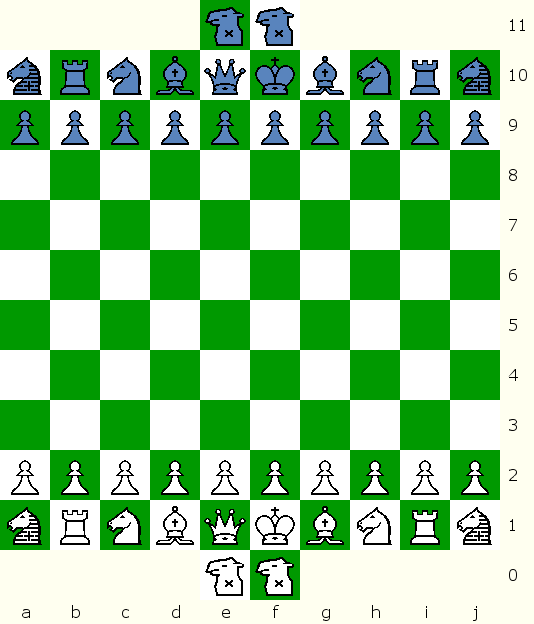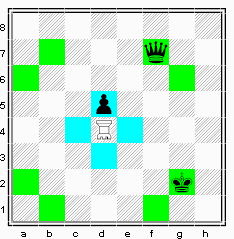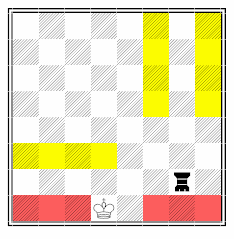Sorcerer Chess
The game is played identical to chess, except for extended initial pawn move and en-passant rules, flexible castling and the 2 new pieces. Additionally, the optional drop rule can be applied to bring 3 new pieces into the game: the Ninja Pawn, the Gryphon and the Anti-Gryphon.
This game will specially appeal to those who like long leaping pieces.Setup

|
Start Position for white. (black mirrors white)
Sorcerers on a1,j1 Rooks on b1,i1 knights on c1,h1 bishops on d1, g1 queen on e1 king on f1 Conjurers on e0,f0 pawns from a2-j2 |
Board Setup #2
 |
Start Position for white. (black mirrors white)
Conjurers on a1,j1 Rooks on b1,i1 knights on c1,h1 bishops on d1, g1 queen on e1 king on f1 Sorcerers on e0,f0 pawns from a2-j2 |
Pieces
The Sorcerer's Moves
The Sorcerer possesses two modes of movement.-
Movement:
- Move one step orthogonally (horizontally or vertically)
- Leap to the square by travelling three horizontal/vertical and two squares perpendicular (3,2 leap).
An alternative way of remembering this move: Leap one square orthogonal and then two squares diagonally from over that square.
 |
The Sorcerer on d4 is attacking all the pieces in the diagram.
It can jump to the squares in green, or move to the blue squares. It can capture the pawn on d5 by moving to that square. It is checking the black king at g2 and attacking the black queen at f7. |
The Conjurer’s Moves
The Conjurer too possesses a dual movement.-
Movement:
- move one step in diagonally
- Leap to the square by travelling three horizontal/vertical and one squares perpendicular (3,1 leap).
The Conjurer is a compound piece. It combines the movement of the pieces early in chess history:
The Camel (for the 3,1 leap) and the Ferz for the one diagonal step.
The commercial chess variant: Omega Chess, has a piece called the Wizard
which is identical to the Conjurer. So for all intents and purposes the Conjurer can also be referred to as the Wizard.
 |
The Conjurer on d4 can capture can step to any of the blue squares. It can also jump to the squares in green. It can capture the pawn on e5 by moving to that square. It can capture the knight on e7 by leaping to that square. |
Reinforcements
While the above pieces alone can be used for a satisfactory game, play can be enhanced by invoking the Drop Rule and dropping 4 Ninja Pawns, the Stealth Gryphon and the Anti-Gryphon.The Ninja Pawn
The ninja pawn possesses slightly different modes of movement and capture depending on which half of the board it is on.Movement:
The ninja pawn can always move 1 square up or 1 square sideways to an empty square from any part of the board.
When the pawn is situated in the lower half of the board (for White, rank 0-5 and for black 11-6), it can move forward multiple vacant squares (1-5 squares) to reach the middle of the board (rank 5 for White or rank 6 for Black). This move can be done at any time regardless of how many times the pawn has moved. Thus White can on each turn move from e0-e2, e2-d2 and d2-d5.
Once it passes the middle, the ninja pawn can only move 1 square forward at a time, or move 1 square horizontally.
Capture:
Like the standard pawn it can capture one square diagonally up, regardless of which half of the board it is on.
When the ninja pawn is on the top half of board (White rank 6 +, Black rank 5-) , it can also capture one square horizontally.
There is no en passant. It cannot capture another pawn or ninja pawn en passant nor can any other pawn capture it this way.
Promotion: The ninja pawn promotes on the last row (rank 10 for white, rank 1 for black), to any piece. Promotion to a piece is mandatory so it would cease to be a pawn in the last row.
 |
In diagram, the black ninja pawn can go from e11-e6 or any other square in between or e11 to f11. The white pawn at f8 cannot capture it en passant Lets say the white ninja pawn went from e0-e2 , it still has the option of shooting forward to the middle regardless of how many moves it made before. e.g. it can go e0-e2, then e2-d2 . It can now (see diagram) go d2-d5 if unobstructed.The white ninja pawn at h9 can capture the bishop at i9 in addition to being able to go to g9 or to promote by going to h10. |
The Stealth Gryphon
The Stealth Gryphon is a potentially powerful piece that can control multiple files and ranks if used effectively, and its awkward move can catch an unsuspecting opponent by surprise.Movement/Capture by replacement: It must move along any unobstructed path (it cannot leap) of 1 square diagonally followed by 2 or more squares horizontally or vertically outwards. Thus, it can reach its destination square only one way but it can exert a powerful influence when not blocked.
The Achilles heel of the Gryphon (and the Anti-Gryphon) is its susceptibility to having its path blocked, and its vulnerability to close range attack.
 |
Partial board shows white king on e0 and black Stealth Gryphon on h1. Red is "offboard". Here the griffon is hampered by the edge of the board but still exerts great influence. It controls the squares in yellow but it is not checking king because it needs to go one diagonal first and then 2 or more orthogonal outwards and there is no such path towards the king. |
The Stealth Anti-Gryphon
The Stealth Anti-Gryphon is the exact inverse of the Stealth Gryphon, and so controls multiple diagonals.Movement/Capture by replacement: It must move along any unobstructed path (it cannot leap) of 1 square horizontally or vertically followed by 2 or more squares diagonally outwards.
 |
Partial board shows black Stealth Anti-Gryphon on e4. Note that it will control more squares on the actual board. Anti-Gryphon shown controls the squares in yellow. Notice its long-range prowess but short-range vulnerability. Esp note how easily a piece can block its path. |
Rules
The rules are as in orthodox chess except as noted below:-
Pawn moves: A pawn situated on the lower half of the board can at any time move forward 1-3 vacant squares to reach the center of the board (rank 5 for white, rank 6 for black). Once the pawn reaches the center row, it can move forward only one square at a time.
Some examples: The white pawn at f2 can start f2-f5 or it can move f2-f4 then f4-f5, or f2-f3 followed by f3-f5, or move f2-g3 to capture enemy piece at g3 followed by g3-g5 next time it moves. - En Passant: If a Pawn moves two or three squares initially and passes an opposing Pawn on the fourth or fifth rank, the Pawn may be captured en passant. E.g. White pawn on a2 black pawn on b4. If the white pawn moves from a2 to a4 or a5, the black pawn on b4 can capture it as if it had moved to a3. Similarly, if the black pawn is on b5 instead and the white pawn moves to a5 from a2 then the black pawn can capture the white pawn as if it moved to a4. Note in this case the white pawn can still avoid the black pawn by moving to a3 instead.
If a pawn slides forward 2 squares on its second move, it can also be captured en passant by an opposing pawn on the fifth rank. E.g. white pawn on a3 and black pawn on b5. White plays a3-a5, black pawn on b5 can capture the pawn en passant by moving to a4.
Capturing en passant is optional unless it is the only legal move available. The capture must be made on the next move. - Pawn promotion: Pawns can now promote to: queen, bishop, knight, rook, Conjuror or Sorcerer on the 10th rank only.
-
Castling:
The usual castling criteria apply: No piece must be in between the spaces travelled by the king and castling rook, cannot castle out of check,
King cannot pass over or land on squares attacked by enemy, but rook can.
There are 7 possible castling positions: The choice of queenside castling positions will depend on whether it is immediately necessary for the king to be nearer the wing or for the rook to be centralized. Note that the rook must always be next to the king after castling.-
1 space transposition - King Side Castling
White moves King one space from f1-g1 and rook from i1-f1
Black moves King one space from f10-g10 and rook from i10-f10 -
1 space transposition - Queen Side Castling
White moves King one space from f1-e1 and rook from b1-f1
Black moves King one space from f10-e10 and rook from b10-f10 -
2 space transposition - King Side Castling
White moves King two spaces from f1-h1 and rook from i1-g1
Black moves King two spaces from f10-h10 and rook from i10-g10 -
2 space transposition - Queen Side Castling
White moves King two spaces from f1-d1 and rook from b1-e1
Black moves King two spaces from f10-d10 and rook from b10-e10 -
3 space transposition - King Side Castling
White moves King three spaces from f1-i1 and rook from i1-h1
Black moves King three spaces from f10-i10 and rook from i10-h10 -
3 space transposition - Queen Side Castling
White moves King three spaces from f1-c1 and rook from b1-d1
Black moves King three spaces from f10-c10 and rook from b10-d10 -
4 space transposition - Queen Side Castling
White moves King four spaces from f1-b1 and rook from b1-c1
Black moves King four spaces from f10-b10 and rook from b10-c10
-
1 space transposition - King Side Castling
- The optional rule described below can be employed to create an even more exciting game.
Reinforcements - Dropping pieces
Players have the option to drop 4 Ninja Pawns, 1 Stealth Gryphon and 1 Anti-Gryphon during the game.- A piece may be dropped on any empty rear square (e0,f0 for white, e11,f11 for black) at any time.
- Dropping a piece constitutes a move.
- A piece can deliver check or checkmate when dropped.
- A piece can block a check when dropped.
- Pawns/ninja pawns can promote to any piece that dropped into play for that side i.e. if side A drops a Gryphon than a pawn can promote to it regardless of if the piece is still on the board. But if side A has not yet dropped the Gryphon than the pawn cannot promote to it.
Notes
- The original start position has very similar weak points as the 8x8 standard chess game. For example the pawns g2 or g9 are protected only by their respective kings.
- The center pawns free the bishops just like in standard chess. And, (in board #1) instead of the knights, the Conjurers attack the center pawns. For example, f2-f5 f9-f6 white can play f0-g3 . Later white can play g1-c5 striking at black's weak point.
- While the Sorcerers and Conjurers can be quite powerful in the opening and middle stages of the game, they cannot force the checkmate of the opposite king with the aid of their king.
 This 'user submitted' page is a collaboration between the posting user and the Chess Variant Pages. Registered contributors to the Chess Variant Pages have the ability to post their own works, subject to review and editing by the Chess Variant Pages Editorial Staff.
This 'user submitted' page is a collaboration between the posting user and the Chess Variant Pages. Registered contributors to the Chess Variant Pages have the ability to post their own works, subject to review and editing by the Chess Variant Pages Editorial Staff.
By Charles Daniel.
Web page created: 2008-02-02. Web page last updated: 2008-02-02
